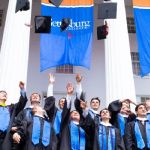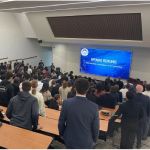
Original research in any field isn’t easy. Now imagine you are in a summer course in Colorado, learning how to code for the first time, and creating a unique computer program to process hundreds of satellite images – the process doesn’t get any less complex.
 But this is exactly what Katie Cavanaugh ’16 did for her senior honors thesis in environmental studies, and her findings reveal changes in forest greenness likely associated with effects of climate change.
But this is exactly what Katie Cavanaugh ’16 did for her senior honors thesis in environmental studies, and her findings reveal changes in forest greenness likely associated with effects of climate change.
It was her classwork in both Platt’s Introduction to Geographic Information Systems and his Remote Sensing classes that made him think of her for this type of project. After meeting with Cavanaugh to discuss a senior honors thesis, he proposed the idea, and she took off with it.
“Katie is quantitatively oriented and wanted to take on a project that involved a bit of computer programming. Beyond that she was open to any research topic,” said her honors thesis advisor Prof. Rud Platt. “I suggested that she use her coding skills to tap into a deep archive of satellite images to study where and how photosynthetic activity— or greenness—in Colorado forests has changed over the last 30 years.”
“Using the satellite images gave us a very broad entry point into the project,” explained Cavanaugh. “There were a lot of different topics that we could have examined, but the study area and topic had to be very well defined.”
The Gettysburg connection
While Cavanaugh knew long before coming to Gettysburg that she wanted to focus on environmental studies in college, she also knew that she wanted more out of her college experience than an expertise in one academic discipline.
In fact, the ability to balance her academic passion with athletics and co-curriculars was a quality that attracted her to Gettysburg when she first visited the campus.
“Track has always been a huge part of my life, so I first came here to check out the facilities and meet with the coach,” Cavanaugh explained. “I was able to meet with a few students and heard them talk about how they were able to do everything here. All of them had a well-rounded experience—from their choice of majors to their campus involvement—and I knew that was what I wanted, too.”
She declared an environmental studies major and has also been able to double minor in physics and Latin, even earning high enough marks to be inducted into the Latin honors fraternity, of which she served as its president. Outside of the classroom, she joined Greek life as a member of Chi Omega and participated in both outdoor and indoor track all four years, serving as the captain during her senior year.

In fact, Cavanaugh excelled on the track team and finished her career as a two-time All-American. As a senior, she finished sixth in the 60-meter hurdles at the NCAA Division III Indoor Championships, and she was also sixth in the 100-meter hurdles at the NCAA Division III Outdoor Championships. She also holds multiple school and Centennial Conference records in the hurdles and sprints.
“Katie’s not only a really great, conscientious person, but she also has incredible time management skills,” Platt stated. “She takes on a lot of different roles, and she not only manages to make them all fit into her schedule, but she does them well, too.”
Working in the field
Cavanaugh’s senior honors topic soon came together: write code to process satellite images of forests in southwestern Colorado over the past 30 years, then analyze changes in forest greenness with respect to environmental conditions (elevation and vegetation type, among other factors) and disturbances (wildfires, and forest treatments, for example). However, simply generating numbers was not enough.
To fully understand the changes she was seeing in the images, Cavanaugh immersed herself in the study area through a summer field course. Taught by environmental studies Prof. Randy Wilson, the course focused on the cultural and physical geography of the Rocky Mountains. Through the course, Cavanaugh learned about the ecology and management of forests in Southwest Colorado. She saw the environmental changes happening to forests first hand, and steeped herself in the scientific literature on them.
The next step was a bit more complicated. With Platt’s help, she taught herself how to code in R, an open source programming language for statistical computing. She developed scripts to process and analyze hundreds of satellite images in her study area going back to 1985.
“I had to test the program with a small subset of images in order to see if it was working the way I needed it to,” Cavanaugh said. “When it finally worked, I felt so accomplished that it had done what it was supposed to do, especially because I was teaching it to myself. It was a very rewarding moment.”
Analyzing the results
 What was even more exciting, she claims, was when the results from her study were consistent with the conditions she examined first hand during her summer field course.
What was even more exciting, she claims, was when the results from her study were consistent with the conditions she examined first hand during her summer field course.
“Elevation was a huge part of my results,” Cavanaugh explained. “A lot of trees were browning at elevations where spring snowpack had decreased the most over the 30 years. That illustrates an impact of climate change.”
Cavanaugh presented her research at the American Association of Geographers (AAG) meetings in San Francisco where she discussed her work with professors and graduate students who are examining the same topics.
“I was just ecstatic that other people were interested in the same things that I was interested in,” she said. “I was able to help them and share my research with them. It was really rewarding.”


